Remove the air duct (B).
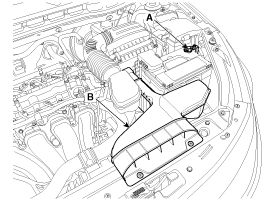
Use fender covers to avoid damaging painted surfaces.
To avoid damaging the cylinder head, wait until the engine coolant temperature drops below normal temperature before removing it.
When handling a metal gasket, take care not to fold the gasket or damage the contact surface of the gasket.
To avoid damage, unplug the wiring connectors carefully while holding the connector portion.
Mark all wiring and hoses to avoid misconnection.
Remove the engine cover.
Disconnect the battery negative terminal (A).
Remove the air duct (B).

Remove the air cleaner assembly.
Disconnect the breather hose (A), the brake booster vacuum hose (B) and the brake booster intensifier hose (C) (AT only).
Disconnect the air intake hose (D) and then remove the air cleaner assembly (E).
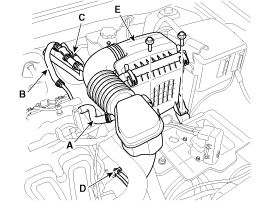
Remove the RH front wheel. (Refer to SS group)
Remove the under cover. (Refer to Engine and transaxle assembly in this group)
Loosen the drain plug, and drain the engine coolant. Remove the radiator cap to help drain the coolant faster. (Refer to Cooling system in this group)
Disconnect the radiator upper hose (A) and lower hose (B).
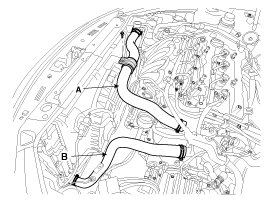
Disconnect the wiring connectors and harness clamps, and remove the wiring and protectors from the cylinder head and intake manifold.
The intake OCV (Oil control valve) connector (A)

The power steering oil pressure switch connector (A) (HPS only) and the exhaust OCV (Oil control valve) connector (B)

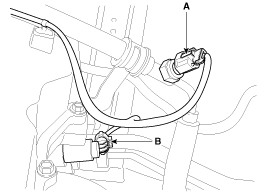
The VIS (Variable intake system) connector (A), the OPS (Oil pressure switch) connector (B), the knock sensor connector (C), the A/C compressor switch connector (D) and the alternator connector (E)
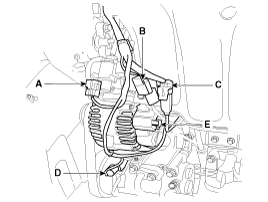
The injector connectors (A) and the ignition coil connectors (B).

The ETC (Electronic throttle control) connector (A) and the MAPS (Manifold absolute pressure sensor) & IATS (Intake air temperature sensor) connector (B)

The exhaust CMPS (Camshaft position sensor) connector (A)

The ECTS (Engine coolant temperature sensor) connector (A), the condenser connector (B), the CKPS (Crankshaft position sensor) connector (C), the front oxygen sensor connector (D)
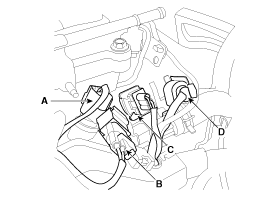
The intake CMPS (Camshaft position sensor) connector (A) and the PCSV (Purge control solenoid valve) connector (B)
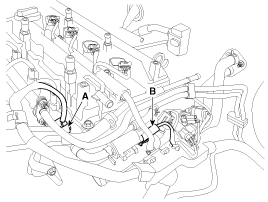
Disconnect the heater hose (A).
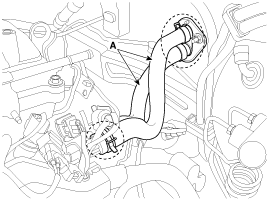
Disconnect the fuel hose (A), the brake booster vacuum hose (B), the PCSV (Purge control solenoid valve) hose (C).
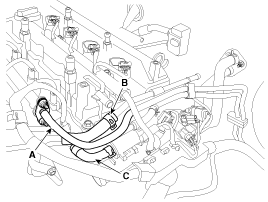
Disconnect the throttle body coolant hoses (A). (if equipped)
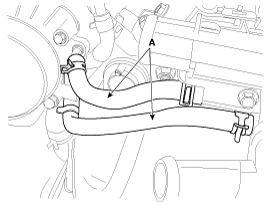
Disconnect the oil cooler coolant hoses (A). (2.4L only)
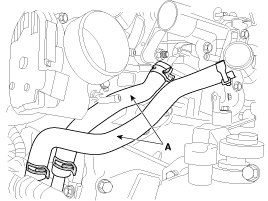
Remove the water temperature control assembly (A) with the water inlet pipe (B).
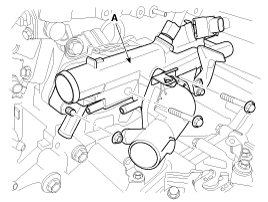
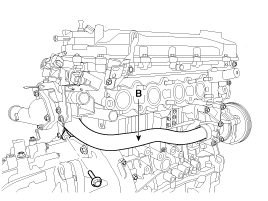
Remove the timing chain. (Refer to Timing system in this group)
Remove the intake and exhaust manifold. (Refer to Intake and exhaust system in this group)
Remove the intake CVVT assembly (A) and exhaust CVVT assembly (B).

When removing the CVVT assembly bolt, prevent the camshaft from rotating by using a wrench at position A.
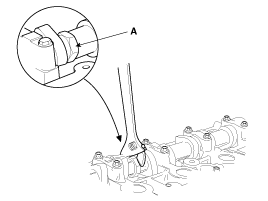
Remove the camshaft.
Remove the front camshaft bearing cap (A) with the upper bearing (B).
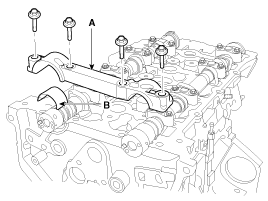
Remove the camshaft bearing cap (A) in the sequence shown.
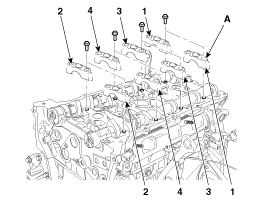
Remove the camshafts (A).
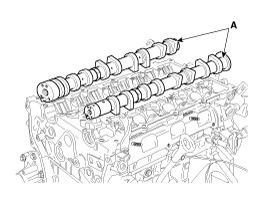
Remove the exhaust camshaft lower bearing (A).
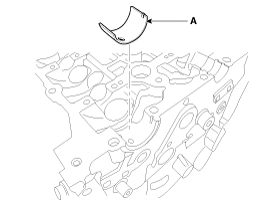
Remove the intake OCV (Oil control valve) (A) using a torx wrench.

Remove the exhaust OCV (Oil control valve) (A) using a torx wrench.

Remove the intake CMPS (Camshaft position sensor) (A).
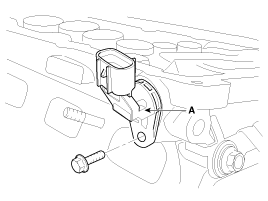
Remove the exhaust CMPS (Camshaft position sensor) (A) after removing the engine hanger and cam position sensor cover (B).
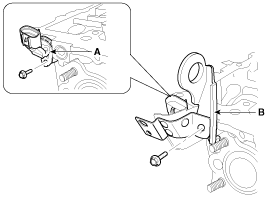
Remove the cylinder head.
Using triple square wrench, uniformly loosen and remove the 10 cylinder head bolts, in several passes, in the sequence shown. Remove the 10 cylinder head bolts and plate washers.
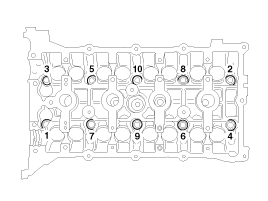
Head warpage or cracking could result from removing bolts in an incorrect order.
Lift the cylinder head (A) from the dowels on the cylinder block and place the cylinder head on wooden blocks on a bench.
Be careful not to damage the contact surfaces of the cylinder head and cylinder block.
Remove the cylinder head gasket (B).
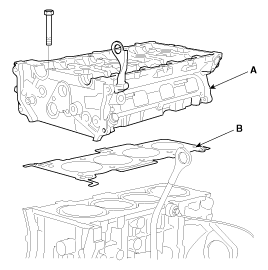
Identify MLA(Mechanical Lash Adjuster), valves, valve springs as they are removed so that each item can be reinstalled in its original position.
Remove the MLAs (A).

Remove the valves.
Using SST (09222-3K000, 09222-3K100), compress the valve spring and remove retainer lock.
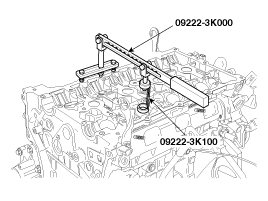
Remove the spring retainer.
Remove the valve spring.
Remove the valve.
Using needle-nose pliers, remove the valve stem seal.
Do not reuse old valve stem seals.
Inspect for flatness.
Using a precision straight edge and feeler gauge, measure the contacting surface of the cylinder block and the manifolds for warpage.
Flatness of cylinder head gasket surface
Standard : Less than 0.05mm (0.0019in.) for total area
Less than 0.02mm (0.0007in.) for a section of 100mm (3.9370in.) X 100mm (3.9370in.)
Flatness of manifold mounting surface (Intake/Exhaust)
Standard : Less than 0.10mm (0.0039in.)

Inspect for cracks.
Check the combustion chamber, intake ports, exhaust ports and cylinder block surface for cracks. If cracked, replace the cylinder head.
Inspect valve stems and valve guides.
Using a caliper gauge, measure the inside diameter of the valve guide.
Valve guide inner diameter
Intake / Exhaust : 5.500 ~ 5.512mm (0.21654 ~ 0.21701in.)
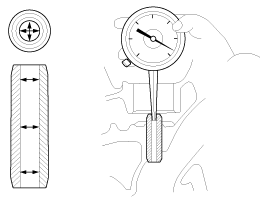
Using a micrometer, measure the diameter of the valve stem.
Valve stem outer diameter
Intake : 5.465 ~ 5.480mm (0.21516 ~ 0.21575in.)
Exhaust : 5.458 ~ 5.470mm (0.214988 ~ 0.21535in.)

Subtract the valve stem diameter measurement from the valve guide inside diameter measurement.
Valve stem-to-guide clearance
[Standard]
Intake : 0.020 ~ 0.047mm (0.00078 ~ 0.00185in.)
Exhaust : 0.030 ~ 0.054mm (0.00118 ~ 0.00212in.)
[Limit]
Intake : 0.070mm (0.00275in.)
Exhaust : 0.090mm (0.00354in.)
If the clearance is greater than maximum, replace the valve or cylinder head.
Inspect the valves.
Check the valve is ground to the correct valve face angle.
Check that the surface of the valve for wear.
If the valve face is worn, replace the valve.
Check the valve head margin thickness.
Valve head thickness (Margin)
[Standard]
Intake : 1.02mm(0.0401in.)
Exhaust : 1.09mm(0.0429in.)

If the margin thickness is less than minimum, replace the valve.
Check the valve length.
Valve length
[Standard]
Intake : 113.18mm(4.4559in.)
Exhaust : 105.84mm(4.1669in.)
[Limit]
Intake : 112.93mm(4.4461in.)
Exhaust : 105.59m(4.1571in.)
Check the surface of the valve stem tip for wear.
If the valve stem tip is worn, replace the valve.
Inspect the valve seats
Check the valve seat for evidence of overheating and improper contact with the valve face. Replace the cylinder head if necessary.
Check the valve guide for wear. If the valve guide is worn, replace the cylinder head.
Inspect the valve springs.
Using a steel square, measure the out-of-square of the valve spring.
Using a vernier calipers, measure the free length of the valve spring.
Valve spring
[Standard]
Free height : 47.44mm (1.8677in.)
Out-of-square : Less than 1.5°
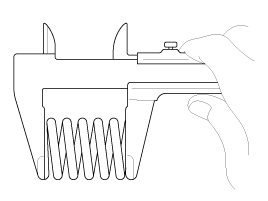
If the free length is not as specified, replace the valve spring.
Inspect the MLA.
Using a micrometer, measure the MLA outside diameter.
MLA outer diameter :
31.964 ~ 31.980mm (1.2584 ~ 1.2590in.)
Using a caliper gauge, measure MLA tappet bore inner diameter of cylinder head.
Tappet bore inner diameter :
32.000 ~ 32.025mm (1.2598 ~ 1.2608in.)
Subtract MLA outside diameter measurement from tappet bore inside diameter measurement.
MLA to tappet bore clearance
[Standard] : 0.020 ~ 0.061mm (0.00078 ~ 0.00240in.)
[Limit] : 0.070mm (0.00275in.)
Inspect the cam lobes.
Using a micrometer, measure the cam lobe height.
Cam height
[Standard value]
Intake : 44.10 ~ 44.30mm (1.7362 ~ 1.7440in.)
Exhaust : 44.90 ~ 45.10mm (1.7677 ~ 1.7756in.)
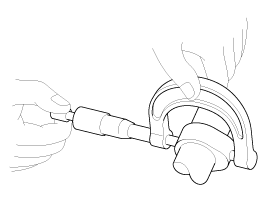
If the cam lobe height is less than standard, replace the camshaft.
Check the surface of the camshaft jurnal for wear. If the jurnal is worn excessively, replace the camshaft.
Inspect the camshaft journal clearance.
Clean the bearing caps and camshaft journals.
Place the camshafts on the cylinder head.
Lay a strip of plastigage across each of the camshaft journal.
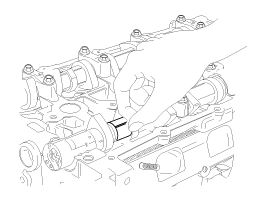
Install the bearing caps.
Do not turn the camshaft.
Remove the bearing caps.
Measure the plastigage at its widest point.
Bearing oil clearance
[Standard value]
Intake :
No.1 : 0.022 ~ 0.057mm (0.00087 ~ 0.00224in.)
No.2, 3, 4, 5 : 0.045 ~ 0.082mm (0.00177 ~ 0.00323in.)
Exhaust:
No.1 : 0 ~ 0.032mm (0 ~ 0.00126in.)
No.2, 3, 4, 5 : 0.045 ~ 0.082mm (0.00177 ~ 0.00323in.)
[Limit]
Intake:
No.1 : 0.090mm (0.00354in.)
No.2, 3, 4, 5 : 0.120mm (0.00472in.)
Exhaust :
No.1 : 0.090mm (0.00354in.)
No.2, 3, 4, 5 : 0.120mm (0.00472in.)

If the oil clearance is greater than maximum, replace the camshaft. If necessary, replace cylinder head.
Completely remove the plastigage.
Remove the camshafts.
Inspect the camshaft end play.
Install the camshafts.
Using a dial indicator, measure the end play while moving the camshaft back and forth.
Camshaft end play
[Standard value] : 0.04 ~ 0.16mm (0.0016 ~ 0.0063in.)
[Limit] : 0.20mm (0.0078in.)
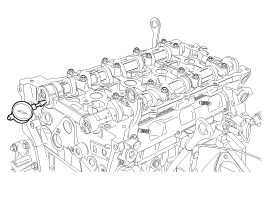
If the end play is greater than maximum, replace the camshaft. If necessary, replace cylinder head.
Remove the camshafts.
Check the cylinder head bore mark.

Class | Mark | Exhaust No.1 Inside Diameter Of Cylinder Head Bore |
a | A | 40.000 ~ 40.008mm (1.57480 ~ 1.5751in.) |
b | B | 40.008 ~ 40.016mm (1.57511 ~ 1.57543in.) |
c | C | 40.016 ~ 40.021mm (1.57543 ~ 1.57563in.) |
Select class of camshaft bearing same as class of cylinder head as shown on the table below.

Cylinder Head Bore Class | Bearing Class For Installing (Color) | Thickness Of Bearing |
a (A) | C (Green) | 1.996~2.000mm (0.07858~0.07874in.) |
b (B) | B (None) | 2.000~2.004mm (0.07874~0.07890in.) |
c (C) | A (Black) | 2.004~2.008mm (0.07890~0.07905in.) |
Oil clearance : 0 ~ 0.032mm (0 ~ 0.00126in.)
Inspect the CVVT for smooth rotation.
Clamp the camshaft using a vise. Be careful not to damage the cam lobes and journals in the vise.
Check that the CVVT is locked by turning it clockwise or counterclockwise. It must not rotate.
Intake CVVT : Seal one of the two advance holes in the camshaft journal with tape.
Exhaust CVVT : Seal one of the two retard holes in the camshaft journal with tape.
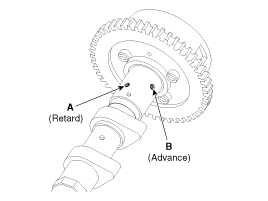
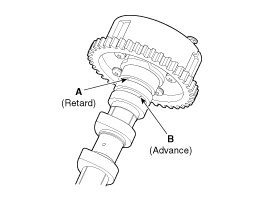
Intake CVVT : Apply approx. 150 kPa (1.5 kgf/㎠, 21 psi ) of compressed air into the unsealed advance hole to release the lock.
Exhaust CVVT : Apply approx. 150 kPa (1.5 kgf/㎠, 21 psi ) of compressed air into the unsealed retard hole to release the lock.
Cover the oil paths with a piece of cloth when applying compressed air to prevent oil from spraying.
Intake CVVT : With compressed air applied, rotate the CVVT into the advance direction (counterclockwise) within its phasing range and check that the CVVT turns smoothly.
Exhaust CVVT : With compressed air applied, rotate the CVVT into the retard direction (clockwise) and check that the CVVT turns smoothly.
CVVT phasing range
Intake : 22.5˚±1˚ (from the most retarded position to the most advanced position)
Exhaust : 20˚±1˚ (from the most advanced position to the most retarded position)
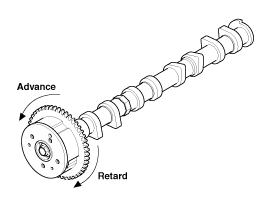
Intake CVVT : Rotate the CVVT into the most retarded position (clockwise) and then check that the CVVT is locked.
Exhaust CVVT : Rotate the CVVT into the most advanced position (counterclockwise) and then check that the CVVT is locked.
Thoroughly clean all parts to be assembled.
Before installing the parts, apply fresh engine oil to all sliding and rotating surfaces.
Replace oil seals with new ones.
Install valves.
Using SST(09222-4A000), push in a new oil seal.
Do not reuse old valve stem seals.
Incorrect installation of the seal could result in oil leakage past the valve guides.
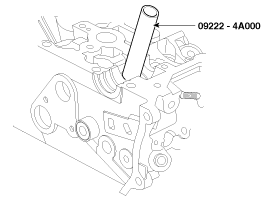
Install the valve, valve spring and spring retainer.
Place valve springs so that the side coated with enamel faces toward the valve spring retainer and then installs the retainer.
Using the SST(09222-3K000, 09222-3K100), compress the spring and install the retainer locks. After installing the valves, ensure that the retainer locks are correctly in place before releasing the valve spring compressor.

Do not press down the valve spring retainer more than 10mm (0.4in.).
Lightly tap the end of each valve stem two or three times with the wooden handle of a hammer to ensure proper seating of the valve and retainer lock.
Install the MLAs after appling engine oil.
Check that the MLA rotates smoothly by hand.
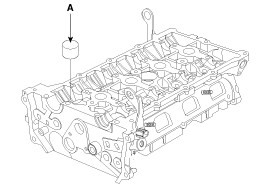
MLA can be reinstalled in its original position.
However, the valve lash clearances must be rechecked and adjusted accordingly before the cylinder head is installed onto the cylinder block.
Refer to General information in EM section for Valve Clearance checking and adjustment procedure.
Thoroughly clean all parts to be assembled.
Always use a new head and manifold gasket.
The cylinder head gasket is a metal gasket. Take care not to bend it.
Rotate the crankshaft, set the No.1 piston at TDC.
Install the cylinder head gasket (A) on the cylinder block.
Be careful of the installation direction.
Apply liquid gasket (Loctite 5900H or equivalent) on the edge of cylinder head gasket upside and downside. (At the position 'B')
After applying sealant, assemble the cylinder head in five minutes.
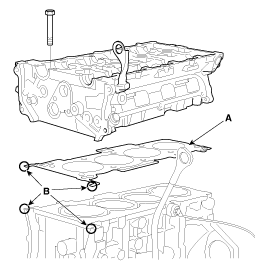
Place the cylinder head carefully in order not to damage the gasket with the bottom part of the end.
Install cylinder head bolts.
Do not apply engine oil on the the cylinder head bolts.
Using the SST(09221-4A000), tighten the cylinder head bolts and plate washers, in several passes, in the sequence shown.
Tightening torque :
32.4~36.3Nm (3.3~3.7kgf.m, 23.9~26.8lb-ft) + 90~95° + 90~95°
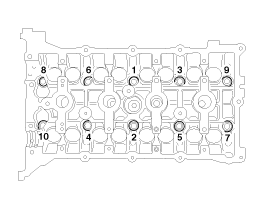
Always use new cylinder head bolt.
Install the intake CMPS (Camshaft position sensor) (A).
Tightening torque :
9.8 ~ 11.8N.m (1.0 ~ 1.2kgf.m, 7.2 ~ 8.7lb-ft)

Install the exhaust CMPS (Camshaft position sensor) (A) and the engine hanger and cam position sensor cover (B).
Tightening torque :
9.8 ~ 11.8N.m (1.0 ~ 1.2kgf.m, 7.2 ~ 8.7lb-ft)

Install the intake OCV (Oil control valve) (A).
Tightening torque :
9.8 ~ 11.8N.m (1.0 ~ 1.2kgf.m, 7.2 ~ 8.7lb-ft)

Install the exhaust OCV (Oil control valve) (A).
Tightening torque :
9.8 ~ 11.8N.m (1.0 ~ 1.2kgf.m, 7.2 ~ 8.7lb-ft)

Do not reuse the OCV when dropped.
Keep the OCV filter clean.
Do not hold the OCV sleeve (A) during servicing.
When the OCV is installed on the engine, do not move the engine with holding the OCV yoke.
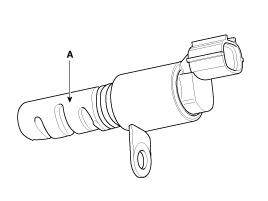
Install the camshafts.
Apply a light coat of engine oil on camshaft journals.
Install the exhaust camshaft lower bearing (A).

Install the camshafts (A).

Install the exhaust camshaft upper bearing (A) to the front bearing cap.
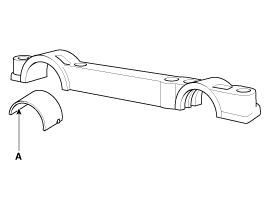
Install camshaft bearing caps (A) in their proper locations.
Tightening order
Group A → Group B → Group C.
Tightening torque :
Step 1
M6 : 5.9N.m (0.6kgf.m, 4.3lb-ft)
M8 : 14.7N.m (1.5kgf.m, 10.8lb-ft)
Step 2
M6 : 10.8 ~ 12.7N.m (1.1 ~ 1.3kgf.m, 8.0 ~ 9.4lb-ft)
M8 : 27.5 ~ 31.4N.m (2.8 ~ 3.2kgf.m, 20.3 ~ 23.1lb-ft)

Be careful not to change the position and direction of bearing caps.
Install the intake CVVT assembly (A) and exhaust CVVT assembly (B).
Tightening torque :
53.9 ~ 63.7N.m (5.5 ~ 6.5kgf.m, 39.7 ~ 47.0lb-ft)

When installing the CVVT assembly bolt, prevent the camshaft from rotating by using a wrench at position A.

Install the intake and exhaust manifold. (Refer to Intake and exhaust system in this group)
Install the timing chain. (Refer to Timing system in this group)
Check and adjust the valve clearance. (Refer to General information in this group)
Install the water temperature control assembly (A) with the water inlet pipe (B).
Tightening torque :
Bolts : 14.7 ~ 19.6N.m (1.5 ~ 2.0kgf.m, 10.8 ~ 14.5lb-ft)
Nut : 18.6 ~ 23.5N.m (1.9 ~ 2.4kgf.m, 13.7 ~ 17.4lb-ft)

Tightening torque :
9.8 ~ 11.8N.m (1.0 ~ 1.2kgf.m, 7.2 ~ 8.7lb-ft)

Assemble water temp control assembly and water inlet pipe to water pump assembly before nuts for assembling of water inlet pipe to be tightened.
Insert after wetting O-ring or inner surface of thermostat housing.
Always use a new O-ring.
Install cylinder head cover.
The hardening sealant located on the upper area between timing chain cover and cylinder head should be removed before assembling cylinder head cover.
After applying sealant (Loctite 5900H or equivalent), it should be assembled within 5 minutes.
Bead width : 2.5mm (0.10in.)
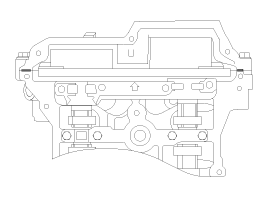
Install the cylinder head cover (A) by tightening the bolts as following method.
Tightening torque :
1st step : 3.9 ~ 5.9N.m(0.4 ~ 0.6kgf.m, 2.9 ~ 4.3lb-ft)
2nd step : 7.8 ~ 9.8N.m(0.8 ~ 1.0kgf.m, 5.8 ~ 7.2lb-ft)
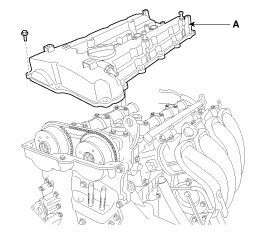

Do not reuse cylinder head cover gasket.
The firing and/or blow out test should not be performed within 30 minutes after the cylinder head cover was assembled.
Connect the oil cooler coolant hoses (A). (2.4L only)

Connect the throttle body coolant hoses (A). (if equipped)

Connect the fuel hose (A), the brake booster vacuum hose (B), the PCSV (Purge control solenoid valve) hose (C).

Connect the heater hose (A).

When installing the heater hoses, install as shown in illustrations.

Connect the wiring connectors and harness clamps, and install the wiring and protectors to the cylinder head and intake manifold.
The intake OCV (Oil control valve) connector (A)

The power steering oil pressure switch connector (A) (HPS only) and the exhaust OCV (Oil control valve) connector (B)


The VIS (Variable intake system) connector (A), the OPS (Oil pressure switch) connector (B), the knock sensor connector (C), the A/C compressor switch connector (D) and the alternator connector (E)

The injector connectors (A) and the ignition coil connectors (B).

The ETC (Electronic throttle control) connector (A) and the MAPS (Manifold absolute pressure sensor) & IATS (Intake air temperature sensor) connector (B)

The exhaust CMPS (Camshaft position sensor) connector (A)

The ECTS (Engine coolant temperature sensor) connector (A), the condenser connector (B), the CKPS (Crankshaft position sensor) connector (C), the front oxygen sensor connector (D)

The intake CMPS (Camshaft position sensor) connector (A) and the PCSV (Purge control solenoid valve) connector (B)

Connect the radiator upper hose (A) and lower hose (B).

Install the radiator hoses as shown illustrations.

Install the under cover. (Refer to Timing system in this group)
Remove the RH front wheel. (Refer to SS group)
Install the air cleaner assembly.
Install the air cleaner assembly (E) and then connect the air intake hose (D).
Tightening torque
Hose clamp bolt :
2.9 ~ 4.9N.m (0.3 ~ 0.5kgf.m, 2.2 ~ 3.6lb-ft)
Air cleaner assembly bolts :
7.8 ~ 9.8N.m (0.8 ~ 1.0kgf.m, 5.8 ~ 7.2lb-ft)
Connect the breather hose (A), the brake booster vacuum hose (B) and the intensifier hose (C).

Install the air intake hose while the plate of the hose clamp must be in line with the stopper of the hose.
Install the air intake hose while the center of the mark of hose must be in line with the throttle body rib.
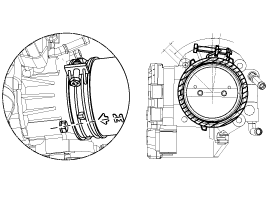
Install the air duct (B).
Connect the battery negative terminal (A).
Tightening torque:
Without battery sensor :
7.8 ~ 9.8N.m (0.8 ~ 1.0kgf.m, 5.8 ~ 7.2lb-ft)
With battery sensor :
4.0 ~ 6.0N.m (0.4 ~ 0.6kgf.m, 3.0 ~ 4.4lb-ft)

Install the engine cover.
Perform the following :
Adjust a shift cable.
Refill engine with engine oil.
Refill a transaxle with fluid.
Refill a radiator and a reservoir tank with engine coolant.
Clean battery posts and cable terminals and assemble.
Inspect for fuel leakage.
After assemble the fuel line, turn on the ignition switch (do not operate the starter) so that the fuel pump runs for approximately two seconds and fuel line pressurizes.
Repeat this operation two or three times, then check for fuel leakage at any point in the fuel line.
Bleed air from the cooling system.
Start engine and let it run until it warms up. (until the radiator fan operates 3 or 4 times.)
Turn Off the engine. Check the level in the radiator, add coolant if needed. This will allow trapped air to be removed from the cooling system.
Put radiator cap on tightly, then run the engine again and check for leaks.